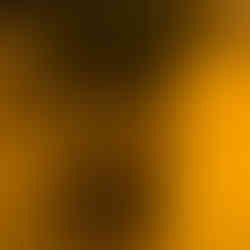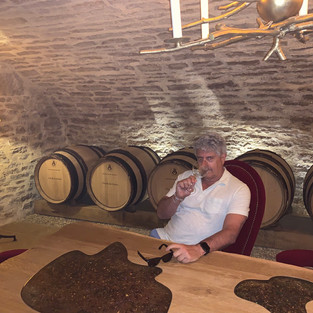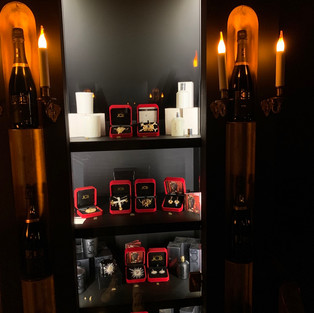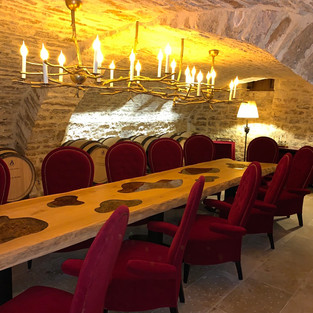Bourgogne IX: DOMAINE DE LA VOUGERAIE
- Paolo Mittiga

- Jul 16, 2019
- 4 min read

The same day we add the in depth visit to the clos de Vougeot, we spent the rest of the early afternoon driving through the most famous grand crus vineyards. At 5Pm we had an appointment at the Domain De La Vougerai. We drove through the winding roads of D974, through an oceans of low trained vineyards. As we arrived, the area was quite and all you could hear was the light breeze touching the vines. As we got in we were welcomed by a young man who claimed that the winery was actually closed and they didn’t expect anybody. As I explained that we did have an appointment , he was very courteous to showed us the beautiful winery and to allow us to taste some of their best wines. Inside everything was well decorated with a beautiful tasting room with a long wooden table, all around bottles and prizes won by the Domaine through the years. There was a room where we could watch a video made by a local well known artist. They also had a small museum with the original rooms where the people that cared for the land lived in the 19th century.
The Domaine de la Vougeraie was created in 1999 to combine a family wine estate under one name. La Vougeraie, the family property of Jean-Claude Boisset and his children and successors Nathalie and Jean-Charles, was at the heart of this renaissance, along with the vineyards of Vougeot, where a third of the estate’s vines are located. A singular passion has reigned there ever since, driven by the desire for continual renewal. The vineyards that became Domaine de la Vougeraie were acquired by the Boissets over a nearly 50-year period, beginning with a 5 hectares (12 acres) plot north of Gevrey-Chambertin in 1964. Over time, the family acquired both vineyard plots and entire domaines,making Boisset Family Estates the largest producer of wine in Burgundy.
The original winemaker at the domaine was Pascal Marchand, who turned winemaking duties over to Pierre Vincent in 2006.
The domaine's holdings now include 37 hectares (91 acres) across 29 different appellations. Holdings include the monopoles of Le Clos du Prieuré, where both white and red wines are produced, and the Premier Cru vineyard Le Clos Blanc de Vougeot. Grand Cru holdings include Charmes-ChambertinLes Mazoyères, Bonnes Mares, Musigny, Clos de Vougeot, Corton Le Clos du Roi, and Corton-Charlemagne Le Charlemagne.
Grapes for the domaine's wine are destemmed, crushed, and macerated for 4–5 days. Ambient wild yeast are used for fermentation, which takes place in open wooden vats. The wine is barrel-aged, with the percentage of new barrels ranging from 30% to 100%.
Respecting the environment has always been a top priority at the Domaine de la Vougeraie, where vines have been cultivated according to biodynamic principles since 1999. Biodynamic cultivation goes one step beyond organic cultivation and can be defined as a practice that seeks to reinforce life through “dynamized” natural elements. The aim is to find a balance between soil, plant and man to bring out the best of the terroir. It requires a great deal of time as all preparations are hand-made and applied to the vines in the same way. Biodynamic cultivation is currently applied to the whole estate’s vineyard.
Biodynamic cultivation aims to promote life in the soil where the vine sends down its roots and where everything starts. It is about encouraging biodiversity and increasing the number of microorganisms in the soil that break down the organo-mineral elements so the plant can assimilate them. It promotes vigorous vines that are healthier and more disease-resistant, and in which the grapes carry an imprint of the terroir, which is enhanced and translated into the wine – a “pure” wine.
The work rhythm is guided by the seasons and the planets. Two treatments are combined: plant infusions and dynamized organic and mineral-based preparations.
Dynamization This is, without doubt, the most esoteric part of the concept and the most difficult to explain scientifically. However, the benefits of this process have been demonstrated in many studies. Twenty years ago, agriculturist Claude Bourguignon revealed the benefits of this practice with the presence of twice as many microorganisms in soil cultivated according to biodynamic principles. The “dynamizer”, or stirring machine, loads biodynamic preparations with magnetic and cosmic energies to make them effective. It mixes in alternate directions for ten seconds at a time for twenty minutes, creating a kind of chaos in the preparation.
The Domaine has a very broad production of wines across the Côte d’Or.
A patchwork of 74 plots covering 42 hectares make up the estate, two-thirds on the Côte de Nuits, one-third on the Côte de Beaune, together producing 36 appellations. At the heart is the diamond set among rubies, the legendary monopole of Vougeot Premier Cru Le Clos Blanc de Vougeot.
Lovingly tended soils, low yields for concentrated fruit, which is then handled with extreme care throughout growing cycle, followed by hand-stitched vinification and ageing for each plot: All of this contributes to a style that is all about elegance and the continual quest for a precise expression of terroir.
We left very pleased by the visit, amused by our host who, after we left, took us to a niche hotel owned by the family near by. The hotel was beautiful set within vineyards with a perfect swimming pool so inviting after a hot day like the one we had.
As soon as I will proper taste the wine I purchase at the Domain I will publish the tasting notes .














































































Comments